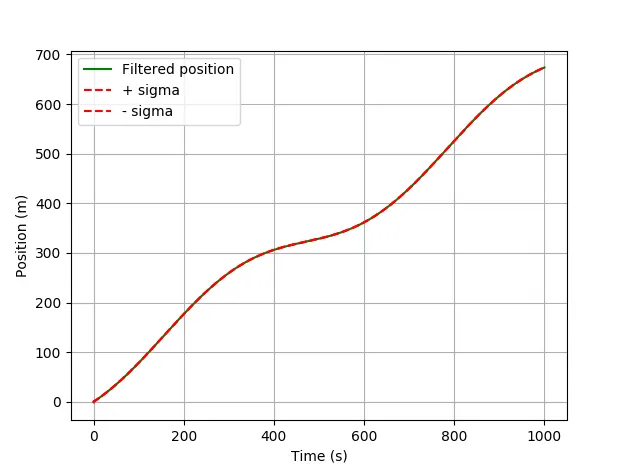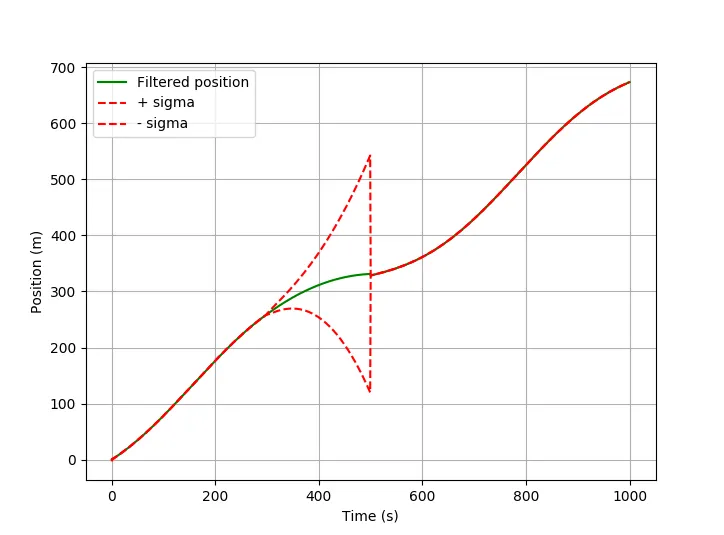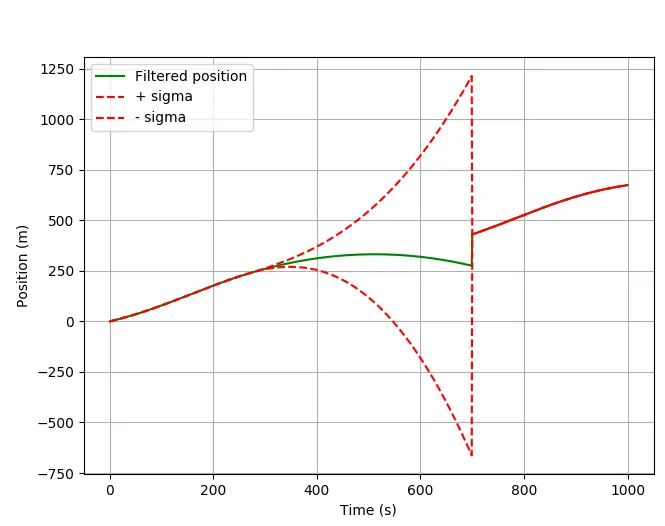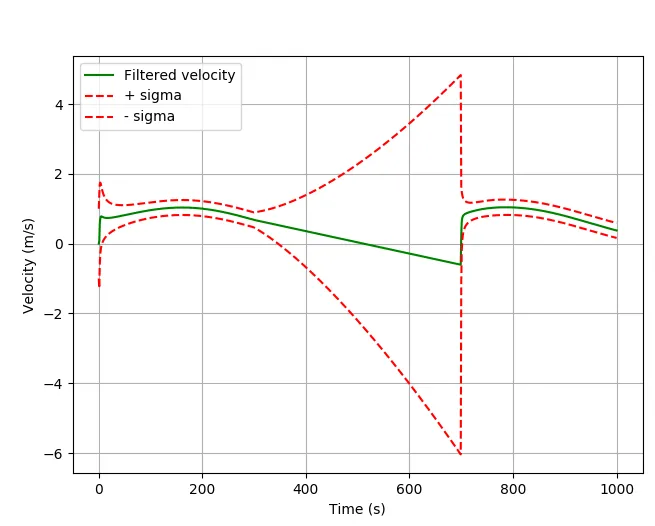让我们来看一下源代码:
filter_update函数中,pykalman检查当前观测值是否被掩盖。
def filter_update(...)
if observation is None:
n_dim_obs = observation_covariance.shape[0]
observation = np.ma.array(np.zeros(n_dim_obs))
observation.mask = True
else:
observation = np.ma.asarray(observation)
这不会影响预测步骤。但是校正步骤有两个选项。它发生在_filter_correct函数中。
def _filter_correct(...)
if not np.any(np.ma.getmask(observation)):
# the normal Kalman Filter math
else:
n_dim_state = predicted_state_covariance.shape[0]
n_dim_obs = observation_matrix.shape[0]
kalman_gain = np.zeros((n_dim_state, n_dim_obs))
# !!!! the corrected state takes the result of the prediction !!!!
corrected_state_mean = predicted_state_mean
corrected_state_covariance = predicted_state_covariance
正如您所看到的,这正是理论方法。
这里有一个简短的例子和可用的工作数据。
假设您有一个GPS接收器,并且您想在步行时跟踪自己。接收器具有很高的精度。为简化起见,假设您只向前直走。

没有什么有趣的事情发生。由于良好的GPS信号,滤波器非常准确地估计了您的位置。如果您有一段时间没有信号会发生什么?

滤波器只能根据现有状态和对系统动态的知识进行预测(请参见矩阵Q)。随着每个预测步骤,不确定性增加。估计位置周围的1-Sigma范围变大。一旦再次出现新的观测,状态就会被纠正。
这是代码和数据:
from pykalman import KalmanFilter
import numpy as np
import matplotlib.pyplot as plt
from numpy import ma
use_mask = 1
Time=[]
X=[]
for line in open('data/dataset_01.csv'):
f1, f2 = line.split(';')
Time.append(float(f1))
X.append(float(f2))
if (use_mask):
X = ma.asarray(X)
X[300:500] = ma.masked
dt = Time[2] - Time[1]
F = [[1, dt, 0.5*dt*dt],
[0, 1, dt],
[0, 0, 1]]
H = [1, 0, 0]
Q = [[ 1, 0, 0],
[ 0, 1e-4, 0],
[ 0, 0, 1e-6]]
R = [0.04]
X0 = [0,
0,
0]
P0 = [[ 10, 0, 0],
[ 0, 1, 0],
[ 0, 0, 1]]
n_timesteps = len(Time)
n_dim_state = 3
filtered_state_means = np.zeros((n_timesteps, n_dim_state))
filtered_state_covariances = np.zeros((n_timesteps, n_dim_state, n_dim_state))
kf = KalmanFilter(transition_matrices = F,
observation_matrices = H,
transition_covariance = Q,
observation_covariance = R,
initial_state_mean = X0,
initial_state_covariance = P0)
for t in range(n_timesteps):
if t == 0:
filtered_state_means[t] = X0
filtered_state_covariances[t] = P0
else:
filtered_state_means[t], filtered_state_covariances[t] = (
kf.filter_update(
filtered_state_means[t-1],
filtered_state_covariances[t-1],
observation = X[t])
)
position_sigma = np.sqrt(filtered_state_covariances[:, 0, 0]);
plt.plot(Time, filtered_state_means[:, 0], "g-", label="Filtered position", markersize=1)
plt.plot(Time, filtered_state_means[:, 0] + position_sigma, "r--", label="+ sigma", markersize=1)
plt.plot(Time, filtered_state_means[:, 0] - position_sigma, "r--", label="- sigma", markersize=1)
plt.grid()
plt.legend(loc="upper left")
plt.xlabel("Time (s)")
plt.ylabel("Position (m)")
plt.show()
更新
如果你遮盖一个更长的时间段(300:700),这个问题看起来更有趣。

正如你所看到的,位置会回退。这是由于转移矩阵 F 的影响,该矩阵将位置、速度和加速度的预测值绑定在一起。
如果您查看速度状态,则可以解释位置的下降。

在 300 秒的时间点上,加速度冻结。速度以恒定的斜率下降并穿过 0 值。此时间点之后,位置必须返回。
要绘制速度,请使用以下代码:
velocity_sigma = np.sqrt(filtered_state_covariances[:, 1, 1]);
plt.plot(Time, filtered_state_means[:, 1], "g-", label="Filtered velocity", markersize=1)
plt.plot(Time, filtered_state_means[:, 1] + velocity_sigma, "r--", label="+ sigma", markersize=1)
plt.plot(Time, filtered_state_means[:, 1] - velocity_sigma, "r--", label="- sigma", markersize=1)
plt.grid()
plt.legend(loc="upper left")
plt.xlabel("Time (s)")
plt.ylabel("Velocity (m/s)")
plt.show()



